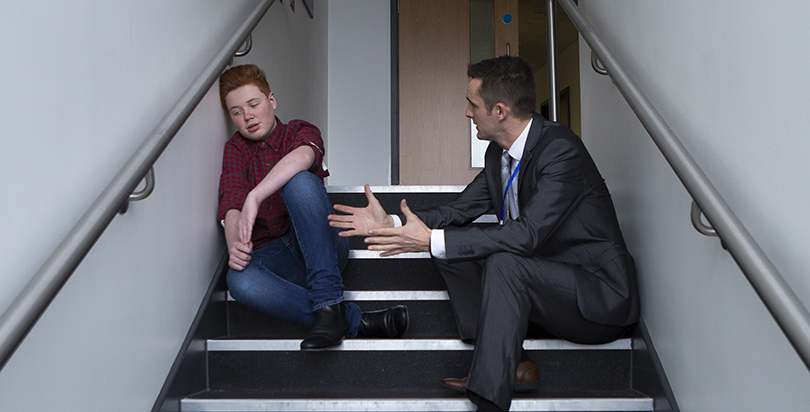1. What is restorative justice?
Restorative justice is an approach to school discipline that emphasizes making the victim and offender whole, as opposed to more traditional, punitive measures. Instead of employing detention, suspension, or expulsion when students commit infractions, restorative justice uses mediation between the offender(s) and the victim(s) involved in an incident. As its adherents describe it, this mediation involves an open discussion of feelings toward each other, possible acceptance of fault on one or more sides, and an agreement of reparations or next steps.
2. How does restorative justice work?
Instead of the initial response to a disciplinary infraction being punitive, restorative justice generally begins with a conference between all those involved in an incident. This includes the victim and perpetrator of any incident, along with at least one facilitator who is grounded in restorative practices. This facilitator or group of facilitators usually includes at least one adult. The conversation that ensues is loosely organized to cover the following points:
- What occurred between the victim and the perpetrator, and why
- How the incident made the victim and perpetrator feel
- The perpetrator’s intent in causing the incident
- Advocacy for reparations from the facilitator(s) and the victim
- Discussion of and resolution for a particular form of restitution
- Agreement from the perpetrator to make restitution and, in some cases, the victim as well, depending on what conflict led up to the incident at hand
3. How did restorative justice start?
Historians trace the first school-based restorative practices to Queensland, Australia in 1994. (Not coincidentally, Australia was one of the first countries to employ restorative justice as an alternative to criminal justice.) As schools experienced success with the techniques, the movement spread. It remains unclear when these techniques began to be adopted by American schools. Howard Zehr is recognized as one of the first and most vocal proponents of restorative justice in the American criminal justice system. Zehr grew the movement in the late 1970s. Concurrently, the approach also gained traction in Canada, and the seeds of interest were planted in juvenile justice and school discipline reform advocates.
4. Do schools practice restorative justice the same way?
The terms restorative practices, circles, and mediations have been used to mean similar things by different schools. There is certainly a range of practices that can be described by one or more of these terms. Each emphasizes different steps in the restorative process, and may employ different protocols for dialogue and agreements. For instance, some schools run circles on a regular basis to build community. These schools feel that they can preemptively make their communities stronger and avoid conflict between members if circle talk is a regular occurrence. When this practice becomes a part of a school’s fabric, dialogue can center around cultural exchanges between community members, ideas about how to improve understanding and relationships, and ways to grow student-centered processes at school. Other schools might only run mediations to handle conflicts, or have a stricter or looser set of protocols. Many likely combine restorative and traditional approaches. All forms of restorative approaches focus on consequences that have a meaningful relationship to the infraction.
5. Is restorative justice becoming more popular? Who is employing it, and who is advocating for it?
Restorative justice appears to be gaining traction in American public schools. The New York City Department of Education invested $2.4 million in pilot programs with restorative approaches to discipline at 20 district schools in June 2015. This year, they added mandatory re-engagement restorative circles for students returning to school from superintendent suspensions. Oakland Unified School District has been implementing restorative practices for over a decade. National advocacy groups (among them Black Lives Matter) have joined the chorus of voices for restorative practices.
States including California and Maryland have moved to restrict suspension practices. At the district level, so have Miami-Dade and Denver. With schools in these areas no longer able to suspend students for a wide range of infractions, they may turn to restorative justice. This is already the case in Los Angeles and Denver.
The federal government’s 2014 guidelines on school climate demonstrated a growing belief about the importance of school disciplinary systems that are less punitive. Both U.S. Education Secretary John King and Democratic presidential candidate Hillary Clinton have called for dismantling the school-to-prison pipeline.
International use of restorative practices has increased as well.
6. Why do some support restorative justice?
Advocates for restorative approaches often emphasize that suspensions are correlated with a number of negative outcomes for students, and have stark racial disparities.
Generally, proponents of restorative justice argue that practicing it, in some form, brings communities together and reduces racial biases and misconceptions, which advocates say are reflected in school suspension and expulsion rates. Additionally, restorative justice supporters feel that students have a significantly better chance of learning and graduating if they are in class as much as possible.
Even a number of charter schools — some of which have been known for strict disciplinary approaches — have embraced less punitive policies, including restorative justice.
7. Why are some people skeptical of restorative justice?
Skeptics of restorative justice often argue that traditional methods of discipline — especially suspensions — get an unfair rap. They claim that disruptive students hurt their peers by taking away learning time and that suspensions can deter misbehavior, while improving outcomes for non-suspended students. (Evidence on this question is mixed, with some research showing positive results of suspensions for students who remain in class, while other studies show negative effects of suspension across the board.)
Other critics of restorative justice worry about the cost, implementation, and potentially time-consuming nature of implementing these practices.
Finally, some advocates of charter schools argue that suspensions are an important tool for managing student behavior, pointing to large achievement gains for many so-called “no excuses” schools that have strict disciplinary policies.
8. Is restorative justice working? How do we know?
It’s hard to say because rigorous scientific studies yielding conclusive evidence on the effect of restorative justice have yet to be conducted. However, qualitative studies relay the following positive outcomes:
- Lower suspension and expulsion rates
- Fewer major disciplinary incidents in school
- Less long-term absenteeism
- Survey responses indicating improved school climate
Very little research on academic improvement as it relates to schools with restorative practices exists, and the qualitative studies that do are mixed. Marginal gains in GPA have been suggested along with a significant rise in graduation rates. However, these data, along with the school climate, truancy, and discipline metrics, should be read cautiously because of methodological limitations. More research needs to be done to conclude with confidence that restorative justice leads to improvements in school climate and student outcomes.
9. Is restorative justice expensive?
Restorative justice can potentially cost significant amounts of money, which many advocates of the practice acknowledge. However, precise estimates of additional costs are hard to come by. The ideal program, according to supporters, includes staff members exclusively dedicated to planning mediations, assisting with facilitation of mediations, and tracking outcomes of mediations. In addition to the cost of additional staff members, staff and faculty should be trained, which could draw significantly on a school’s or district’s budget for professional development.
According to a representative of Teachers Unite — a non-profit that runs workshops in restorative justice for public schools — proper professional development in restorative justice takes significant amounts of time and effort. Additionally, the mediation and restitution process itself generally takes more time to implement than traditional methods.
10. Is restorative justice worth it?
It’s too soon to say, but if the results from qualitative studies are validated by empirical research, the answer may be yes. Given the high correlation between suspension and drop-out rates, and the connection between both drop-outs and incarceration and drop-outs and economic loss, well-run restorative programs could save a great deal of money. Most importantly, the approach has the potential to improve student outcomes and to counteract the school-to-prison pipeline. However, any benefits of restorative justice programs would have to be weighed against additional costs.
11. What’s necessary for restorative justice to be done right?
Even according to advocates, there are many necessities when implementing restorative justice: staff-wide buy-in, training, and the resources to carry out the work. Restorative justice can easily fall apart if it is not practiced consistently or there is insufficient follow-up to ensure agreements are upheld post-conference. This is difficult if some staff members do not believe in its value, training lacks precision or depth, models of practice within a building differ substantially, or there aren’t staff members dedicated to implementing restorative justice effectively.
Get stories like these delivered straight to your inbox. Sign up for The 74 Newsletter


;)
